4.7: Graphs of Polynomial Functions
- Page ID
- 82159
Learning Objectives
- Recognize characteristics of graphs of polynomial functions.
- Use factoring to find zeros of polynomial functions.
- Identify zeros and their multiplicities.
- Determine end behavior.
- Understand the relationship between degree and turning points.
- Graph polynomial functions.
The revenue in millions of dollars for a fictional cable company from 2006 through 2013 is shown in Table \(\PageIndex{1}\).
| Year | 2006 | 2007 | 2008 | 2009 | 2010 | 2011 | 2012 | 2013 |
|---|---|---|---|---|---|---|---|---|
| Revenues | 52.4 | 52.8 | 51.2 | 49.5 | 48.6 | 48.6 | 48.7 | 47.1 |
The revenue can be modeled by the polynomial function
\[R(t)=−0.037t^4+1.414t^3−19.777t^2+118.696t−205.332\]
where \(R\) represents the revenue in millions of dollars and \(t\) represents the year, with \(t=6\) corresponding to 2006. Over which intervals is the revenue for the company increasing? Over which intervals is the revenue for the company decreasing? These questions, along with many others, can be answered by examining the graph of the polynomial function. We have already explored the local behavior of quadratics, a special case of polynomials. In this section we will explore the local behavior of polynomials in general.
Recognizing Characteristics of Graphs of Polynomial Functions
Polynomial functions of degree 2 or more have graphs that do not have sharp corners; recall that these types of graphs are called smooth curves. Polynomial functions also display graphs that have no breaks. Curves with no breaks are called continuous. Figure \(\PageIndex{1}\) shows a graph that represents a polynomial function and a graph that represents a function that is not a polynomial.
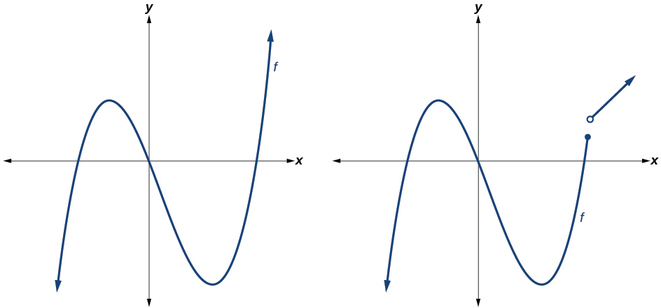
Example \(\PageIndex{1}\): Recognizing Polynomial Functions
Which of the graphs in Figure \(\PageIndex{2}\) represents a polynomial function?
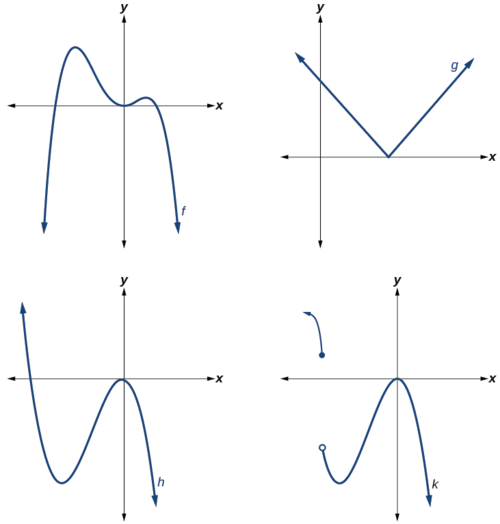
Figure \(\PageIndex{2}\)
Solution
- The graphs of \(f\) and \(h\) are graphs of polynomial functions. They are smooth and continuous.
- The graphs of \(g\) and \(k\) are graphs of functions that are not polynomials. The graph of function \(g\) has a sharp corner. The graph of function \(k\) is not continuous.
Q&A
Do all polynomial functions have as their domain all real numbers?
- Yes. Any real number is a valid input for a polynomial function.
Using Factoring to Find Zeros of Polynomial Functions
Recall that if \(f\) is a polynomial function, the values of \(x\) for which \(f(x)=0\) are called zeros of \(f\). If the equation of the polynomial function can be factored, we can set each factor equal to zero and solve for the zeros.
We can use this method to find \(x\)-intercepts because at the \(x\)-intercepts we find the input values when the output value is zero. For general polynomials, this can be a challenging prospect. While quadratics can be solved using the relatively simple quadratic formula, the corresponding formulas for cubic and fourth-degree polynomials are not simple enough to remember, and formulas do not exist for general higher-degree polynomials. Consequently, we will limit ourselves to three cases in this section:
The polynomial can be factored using known methods: greatest common factor and trinomial factoring.
The polynomial is given in factored form.
Technology is used to determine the intercepts.
How To: Given a polynomial function \(f\), find the \(x\)-intercepts by factoring
- Set \(f(x)=0\).
- If the polynomial function is not given in factored form:
- Factor out any common monomial factors.
- Factor any factorable binomials or trinomials.
- Set each factor equal to zero and solve to find the x-intercepts.
Example \(\PageIndex{2}\): Finding the \(x\)-Intercepts of a Polynomial Function by Factoring
Find the \(x\)-intercepts of \(f(x)=x^6−3x^4+2x^2\).
Solution
We can attempt to factor this polynomial to find solutions for \(f(x)=0\).
\[\begin{align*} x^6−3x^4+2x^2&=0 & &\text{Factor out the greatest common factor.} \\ x^2(x^4−3x^2+2)&=0 & &\text{Factor the trinomial.} \\ x^2(x^2−1)(x^2−2)&=0 & &\text{Set each factor equal to zero.} \end{align*}\]
\[\begin{align*} x^2&=0 & & & (x^2−1)&=0 & & & (x^2−2)&=0 \\ x^2&=0 & &\text{ or } & x^2&=1 & &\text{ or } & x^2&=2 \\ x&=0 &&& x&={\pm}1 &&& x&={\pm}\sqrt{2} \end{align*}\] .
This gives us five \(x\)-intercepts: \((0,0)\), \((1,0)\), \((−1,0)\), \((\sqrt{2},0)\),and \((−\sqrt{2},0)\) (Figure \(\PageIndex{3}\)). We can see that this is an even function.
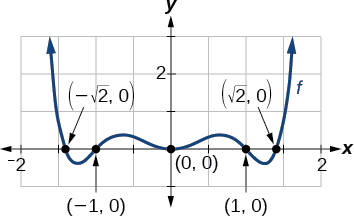
Example \(\PageIndex{3}\): Finding the \(x\)-Intercepts of a Polynomial Function by Factoring
Find the \(x\)-intercepts of \(f(x)=x^3−5x^2−x+5\).
Solution
Find solutions for \(f(x)=0\) by factoring.
\[\begin{align*} x^3−5x^2−x+5&=0 &\text{Factor by grouping.} \\ x^2(x−5)−(x−5)&=0 &\text{Factor out the common factor.} \\ (x^2−1)(x−5)&=0 &\text{Factor the difference of squares.} \\ (x+1)(x−1)(x−5)&=0 &\text{Set each factor equal to zero.} \end{align*}\]
\[\begin{align*} x+1&=0 & &\text{or} & x−1&=0 & &\text{or} & x−5&=0 \\ x&=−1 &&& x&=1 &&& x&=5\end{align*}\]
There are three \(x\)-intercepts: \((−1,0)\), \((1,0)\), and \((5,0)\) (Figure \(\PageIndex{4}\)).
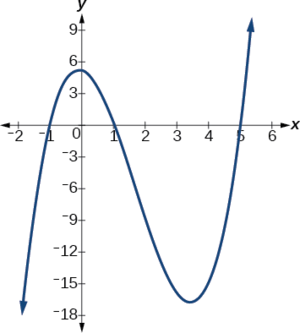
Example \(\PageIndex{4}\): Finding the \(y\)- and \(x\)-Intercepts of a Polynomial in Factored Form
Find the \(y\)- and \(x\)-intercepts of \(g(x)=(x−2)^2(2x+3)\).
Solution
The \(y\)-intercept can be found by evaluating \(g(0)\).
\[\begin{align*} g(0)&=(0−2)^2(2(0)+3) \\ &=12 \end{align*}\]
So the \(y\)-intercept is \((0,12)\).
The \(x\)-intercepts can be found by solving \(g(x)=0\).
\[(x−2)^2(2x+3)=0\]
\[\begin{align*} (x−2)^2&=0 & & & (2x+3)&=0 \\ x−2&=0 & &\text{or} & x&=−\dfrac{3}{2} \\ x&=2 \end{align*}\]
So the \(x\)-intercepts are \((2,0)\) and \(\left(−\dfrac{3}{2},0\right)\).
Analysis
We can always check that our answers are reasonable by using a graphing calculator to graph the polynomial as shown in Figure \(\PageIndex{5}\).
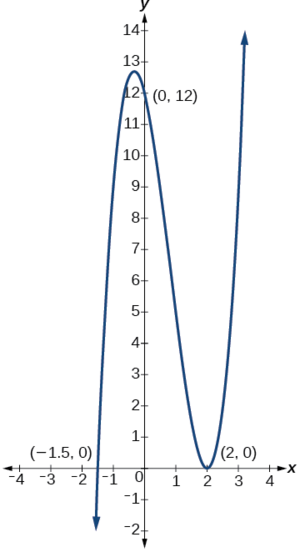
Example \(\PageIndex{5}\): Finding the \(x\)-Intercepts of a Polynomial Function Using a Graph
Find the \(x\)-intercepts of \(h(x)=x^3+4x^2+x−6\).
Solution
This polynomial is not in factored form, has no common factors, and does not appear to be factorable using techniques previously discussed. Fortunately, we can use technology to find the intercepts. Keep in mind that some values make graphing difficult by hand. In these cases, we can take advantage of graphing utilities.
Looking at the graph of this function, as shown in Figure \(\PageIndex{6}\), it appears that there are \(x\)-intercepts at \(x=−3,−2, \text{ and }1\).
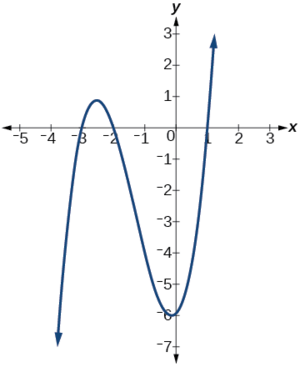
We can check whether these are correct by substituting these values for \(x\) and verifying that
\[h(−3)=h(−2)=h(1)=0. \nonumber\]
Since \(h(x)=x^3+4x^2+x−6\), we have:
\[ \begin{align*} h(−3)&=(−3)^3+4(−3)^2+(−3)−6=−27+36−3−6=0 \\[4pt] h(−2) &=(−2)^3+4(−2)^2+(−2)−6 =−8+16−2−6=0 \\[4pt] h(1)&=(1)^3+4(1)^2+(1)−6=1+4+1−6=0 \end{align*}\]
Each \(x\)-intercept corresponds to a zero of the polynomial function and each zero yields a factor, so we can now write the polynomial in factored form.
\[\begin{align*} h(x)&=x^3+4x^2+x−6 \\ &=(x+3)(x+2)(x−1) \end{align*}\]
Exercise \(\PageIndex{1}\)
Find the \(y\)-and \(x\)-intercepts of the function \(f(x)=x^4−19x^2+30x\).
- Answer
-
- \(y\)-intercept \((0,0)\);
- \(x\)-intercepts \((0,0)\), \((–5,0)\), \((2,0)\), and \((3,0)\)
Identifying Zeros and Their Multiplicities
Graphs behave differently at various \(x\)-intercepts. Sometimes, the graph will cross over the horizontal axis at an intercept. Other times, the graph will touch the horizontal axis and bounce off. Suppose, for example, we graph the function
\[f(x)=(x+3)(x−2)^2(x+1)^3.\]
Notice in Figure \(\PageIndex{7}\) that the behavior of the function at each of the \(x\)-intercepts is different.
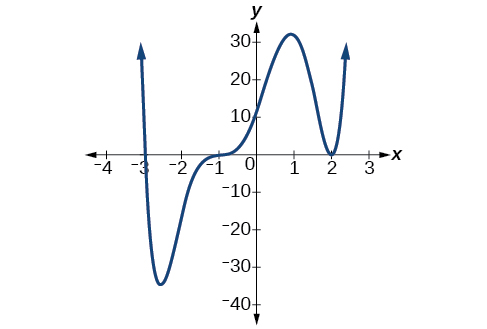
The \(x\)-intercept −3 is the solution of equation \((x+3)=0\). The graph passes directly through the \(x\)-intercept at \(x=−3\). The factor is linear (has a degree of 1), so the behavior near the intercept is like that of a line — it passes directly through the intercept. We call this a single zero because the zero corresponds to a single factor of the function.
The \(x\)-intercept 2 is the repeated solution of equation \((x−2)^2=0\). The graph touches the axis at the intercept and changes direction. The factor is quadratic (degree 2), so the behavior near the intercept is like that of a quadratic—it bounces off of the horizontal axis at the intercept.
\[(x−2)^2=(x−2)(x−2)\]
The factor is repeated, that is, the factor \((x−2)\) appears twice. The number of times a given factor appears in the factored form of the equation of a polynomial is called the multiplicity. The zero associated with this factor, \(x=2\), has multiplicity 2 because the factor \((x−2)\) occurs twice.
The \(x\)-intercept −1 is the repeated solution of factor \((x+1)^3=0\).The graph passes through the axis at the intercept, but flattens out a bit first. This factor is cubic (degree 3), so the behavior near the intercept is like that of a cubic—with the same S-shape near the intercept as the toolkit function \(f(x)=x^3\). We call this a triple zero, or a zero with multiplicity 3.
For zeros with even multiplicities, the graphs touch or are tangent to the \(x\)-axis. For zeros with odd multiplicities, the graphs cross or intersect the \(x\)-axis. See Figure \(\PageIndex{8}\) for examples of graphs of polynomial functions with multiplicity 1, 2, and 3.
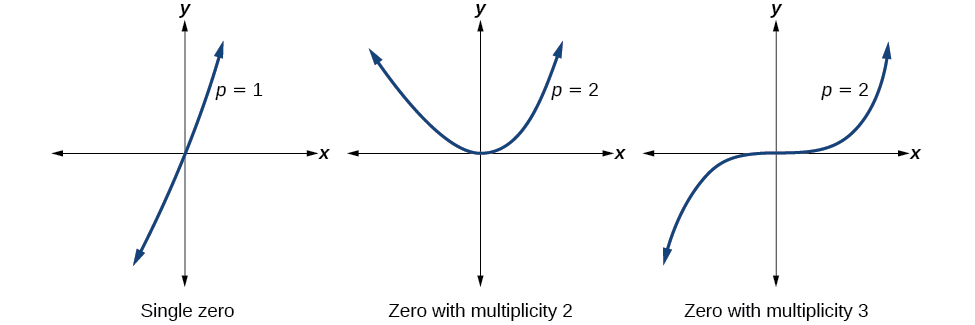
For higher even powers, such as 4, 6, and 8, the graph will still touch and bounce off of the horizontal axis but, for each increasing even power, the graph will appear flatter as it approaches and leaves the \(x\)-axis.
For higher odd powers, such as 5, 7, and 9, the graph will still cross through the horizontal axis, but for each increasing odd power, the graph will appear flatter as it approaches and leaves the \(x\)-axis.
Graphical Behavior of Polynomials at \(x\)-Intercepts
If a polynomial contains a factor of the form \((x−h)^p\), the behavior near the x-intercepth is determined by the power \(p\). We say that \(x=h\) is a zero of multiplicity \(p\).
The graph of a polynomial function will touch the x-axis at zeros with even multiplicities. The graph will cross the x-axis at zeros with odd multiplicities.
The sum of the multiplicities is the degree of the polynomial function.
HOWTO: Given a graph of a polynomial function of degree \(n\), identify the zeros and their multiplicities
- If the graph crosses the \(x\)-axis and appears almost linear at the intercept, it is a single zero.
- If the graph touches the \(x\)-axis and bounces off of the axis, it is a zero with even multiplicity.
- If the graph crosses the \(x\)-axis at a zero, it is a zero with odd multiplicity.
- The sum of the multiplicities is \(n\).
Example \(\PageIndex{6}\): Identifying Zeros and Their Multiplicities
Use the graph of the function of degree 6 in Figure \(\PageIndex{9}\) to identify the zeros of the function and their possible multiplicities.
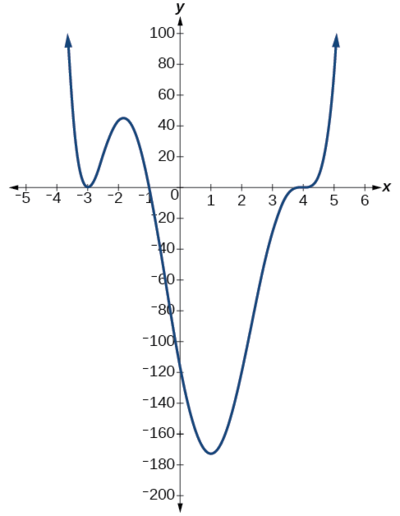
Solution
The polynomial function is of degree \(n\). The sum of the multiplicities must be \(n\).
Starting from the left, the first zero occurs at \(x=−3\). The graph touches the x-axis, so the multiplicity of the zero must be even. The zero of −3 has multiplicity 2.
The next zero occurs at \(x=−1\). The graph looks almost linear at this point. This is a single zero of multiplicity 1.
The last zero occurs at \(x=4\).The graph crosses the x-axis, so the multiplicity of the zero must be odd. We know that the multiplicity is likely 3 and that the sum of the multiplicities is likely 6.
Exercise \(\PageIndex{2}\)
Use the graph of the function of degree 5 in Figure \(\PageIndex{10}\) to identify the zeros of the function and their multiplicities.
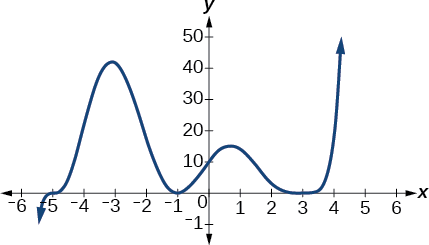
Figure \(\PageIndex{10}\): Graph of a polynomial function with degree 5.
- Answer
-
The graph has a zero of –5 with multiplicity 1, a zero of –1 with multiplicity 2, and a zero of 3 with even multiplicity.
Determining End Behavior
As we have already learned, the behavior of a graph of a polynomial function of the form
\[f(x)=a_nx^n+a_{n−1}x^{n−1}+...+a_1x+a_0\]
will either ultimately rise or fall as \(x\) increases without bound and will either rise or fall as \(x\) decreases without bound. This is because for very large inputs, say 100 or 1,000, the leading term dominates the size of the output. The same is true for very small inputs, say –100 or –1,000.
Recall that we call this behavior the end behavior of a function. As we pointed out when discussing quadratic equations, when the leading term of a polynomial function, \(a_nx^n\), is an even power function, as \(x\) increases or decreases without bound, \(f(x)\) increases without bound. When the leading term is an odd power function, as \(x\) decreases without bound, \(f(x)\) also decreases without bound; as \(x\) increases without bound, \(f(x)\) also increases without bound. If the leading term is negative, it will change the direction of the end behavior. Figure \(\PageIndex{11}\) summarizes all four cases.
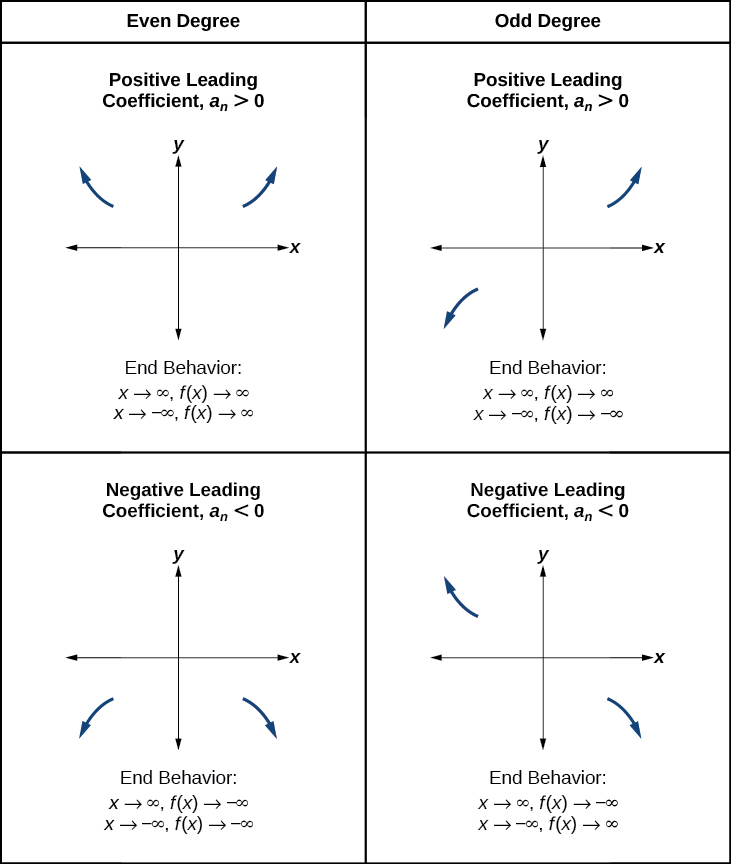
Understanding the Relationship between Degree and Turning Points
In addition to the end behavior, recall that we can analyze a polynomial function’s local behavior. It may have a turning point where the graph changes from increasing to decreasing (rising to falling) or decreasing to increasing (falling to rising). Look at the graph of the polynomial function \(f(x)=x^4−x^3−4x^2+4x\) in Figure \(\PageIndex{12}\). The graph has three turning points.
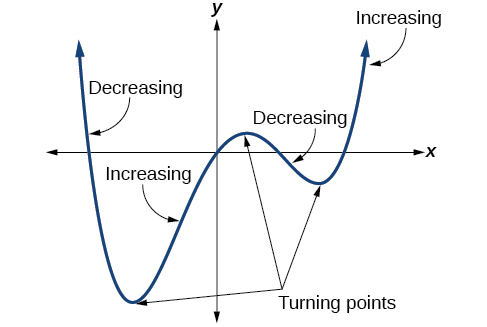
This function \(f\) is a 4th degree polynomial function and has 3 turning points. The maximum number of turning points of a polynomial function is always one less than the degree of the function.
Definition: Interpreting Turning Points
A turning point is a point of the graph where the graph changes from increasing to decreasing (rising to falling) or decreasing to increasing (falling to rising). A polynomial of degree \(n\) will have at most \(n−1\) turning points.
Example \(\PageIndex{7}\): Finding the Maximum Number of Turning Points Using the Degree of a Polynomial Function
Find the maximum number of turning points of each polynomial function.
- \(f(x)=−x^3+4x^5−3x^2+1\)
- \(f(x)=−(x−1)^2(1+2x^2)\)
Solution
a. \(f(x)=−x^3+4x^5−3x^2+1\)
First, rewrite the polynomial function in descending order: \(f(x)=4x^5−x^3−3x^2+1\)
Identify the degree of the polynomial function. This polynomial function is of degree 5.
The maximum number of turning points is \(5−1=4\).
b. \(f(x)=−(x−1)^2(1+2x^2)\)
First, identify the leading term of the polynomial function if the function were expanded.

Then, identify the degree of the polynomial function. This polynomial function is of degree 4.
The maximum number of turning points is \(4−1=3\).
Graphing Polynomial Functions
We can use what we have learned about multiplicities, end behavior, and turning points to sketch graphs of polynomial functions. Let us put this all together and look at the steps required to graph polynomial functions.
Howto: Given a polynomial function, sketch the graph
- Find the intercepts.
- Check for symmetry. If the function is an even function, its graph is symmetrical about the y-axis, that is, \(f(−x)=f(x)\). If a function is an odd function, its graph is symmetrical about the origin, that is, \(f(−x)=−f(x)\).
- Use the multiplicities of the zeros to determine the behavior of the polynomial at the x-intercepts.
- Determine the end behavior by examining the leading term.
- Use the end behavior and the behavior at the intercepts to sketch a graph.
- Ensure that the number of turning points does not exceed one less than the degree of the polynomial.
- Optionally, use technology to check the graph.
Example \(\PageIndex{8}\): Sketching the Graph of a Polynomial Function
Sketch a graph of \(f(x)=−2(x+3)^2(x−5)\).
Solution
This graph has two \(x\)-intercepts. At \(x=−3\), the factor is squared, indicating a multiplicity of 2. The graph will bounce at this \(x\)-intercept. At \(x=5\),the function has a multiplicity of one, indicating the graph will cross through the axis at this intercept.
The \(y\)-intercept is found by evaluating \(f(0)\).
\[\begin{align*} f(0)&=−2(0+3)^2(0−5) \\ &=−2⋅9⋅(−5) \\ &=90 \end{align*}\]
The \(y\)-intercept is \((0,90)\).
Additionally, we can see the leading term, if this polynomial were multiplied out, would be \(−2x3\), so the end behavior is that of a vertically reflected cubic, with the outputs decreasing as the inputs approach infinity, and the outputs increasing as the inputs approach negative infinity. See Figure \(\PageIndex{13}\).
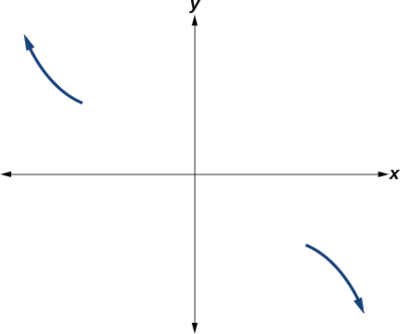
To sketch this, we consider that:
- As \(x{\rightarrow}−{\infty}\) the function \(f(x){\rightarrow}{\infty}\),so we know the graph starts in the second quadrant and is decreasing toward the x-axis.
- Since \(f(−x)=−2(−x+3)^2(−x–5)\) is not equal to \(f(x)\), the graph does not display symmetry.
- At \((−3,0)\), the graph bounces off of the \(x\)-axis, so the function must start increasing.
- At \((0,90)\), the graph crosses the \(y\)-axis at the \(y\)-intercept. See Figure \(\PageIndex{14}\).

Somewhere after this point, the graph must turn back down or start decreasing toward the horizontal axis because the graph passes through the next intercept at \((5,0)\). See Figure \(\PageIndex{15}\).

As \(x{\rightarrow}{\infty}\) the function \(f(x){\rightarrow}−{\infty}\),
so we know the graph continues to decrease, and we can stop drawing the graph in the fourth quadrant.
Using technology, we can create the graph for the polynomial function, shown in Figure \(\PageIndex{16}\), and verify that the resulting graph looks like our sketch in Figure \(\PageIndex{15}\).

Figure \(\PageIndex{16}\): The complete graph of the polynomial function \(f(x)=−2(x+3)^2(x−5)\).
Exercise \(\PageIndex{8}\)
Sketch a graph of \(f(x)=\dfrac{1}{4}x(x−1)^4(x+3)^3\).
- Answer
-
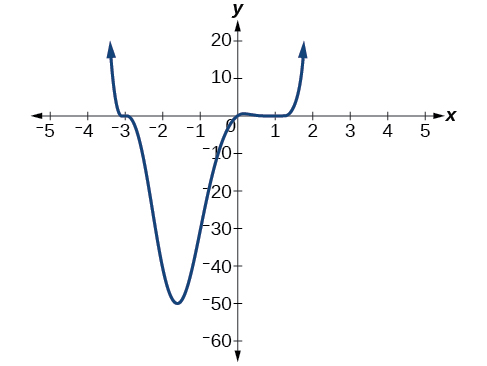
Figure \(\PageIndex{17}\): Graph of \(f(x)=\frac{1}{4}x(x−1)^4(x+3)^3\)
Writing Formulas for Polynomial Functions
Now that we know how to find zeros of polynomial functions, we can use them to write formulas based on graphs. Because a polynomial function written in factored form will have an \(x\)-intercept where each factor is equal to zero, we can form a function that will pass through a set of \(x\)-intercepts by introducing a corresponding set of factors.
Note: Factored Form of Polynomials
If a polynomial of lowest degree \(p\) has horizontal intercepts at \(x=x_1,x_2,…,x_n\), then the polynomial can be written in the factored form: \(f(x)=a(x−x_1)^{p_1}(x−x_2)^{p_2}⋯(x−x_n)^{p_n}\) where the powers \(p_i\) on each factor can be determined by the behavior of the graph at the corresponding intercept, and the stretch factor \(a\) can be determined given a value of the function other than the \(x\)-intercept.
![]() Given a graph of a polynomial function, write a formula for the function.
Given a graph of a polynomial function, write a formula for the function.
- Identify the \(x\)-intercepts of the graph to find the factors of the polynomial.
- Examine the behavior of the graph at the \(x\)-intercepts to determine the multiplicity of each factor.
- Find the polynomial of least degree containing all the factors found in the previous step.
- Use any other point on the graph (the \(y\)-intercept may be easiest) to determine the stretch factor.
Example \(\PageIndex{10}\): Writing a Formula for a Polynomial Function from the Graph
Write a formula for the polynomial function shown in Figure \(\PageIndex{20}\).
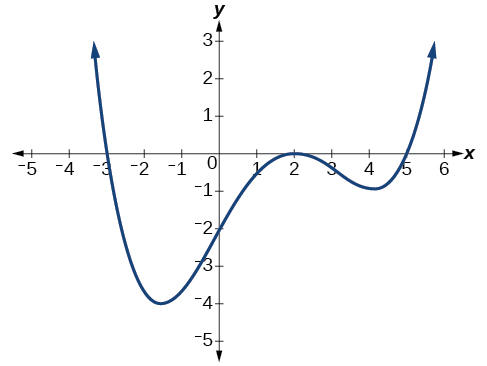
Solution
This graph has three \(x\)-intercepts: \(x=−3,\;2,\text{ and }5\). The y-intercept is located at \((0,2)\).At \(x=−3\) and \( x=5\), the graph passes through the axis linearly, suggesting the corresponding factors of the polynomial will be linear. At \(x=2\), the graph bounces at the intercept, suggesting the corresponding factor of the polynomial will be second degree (quadratic). Together, this gives us
\[f(x)=a(x+3)(x−2)^2(x−5)\]
To determine the stretch factor, we utilize another point on the graph. We will use the \(y\)-intercept \((0,–2)\), to solve for \(a\).
\[\begin{align*} f(0)&=a(0+3)(0−2)^2(0−5) \\ −2&=a(0+3)(0−2)^2(0−5) \\ −2&=−60a \\ a&=\dfrac{1}{30} \end{align*}\]
The graphed polynomial appears to represent the function \(f(x)=\dfrac{1}{30}(x+3)(x−2)^2(x−5)\).
Exercise \(\PageIndex{5}\)
Given the graph shown in Figure \(\PageIndex{21}\), write a formula for the function shown.
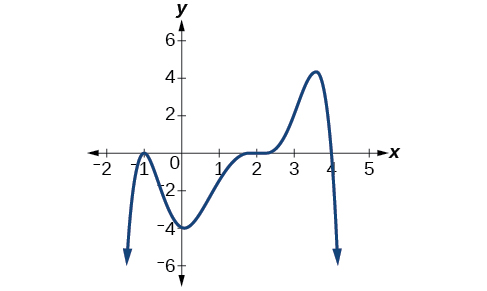
- Answer
-
\(f(x)=−\frac{1}{8}(x−2)^3(x+1)^2(x−4)\)
Key Concepts
- Polynomial functions of degree 2 or more are smooth, continuous functions.
- To find the zeros of a polynomial function, if it can be factored, factor the function and set each factor equal to zero.
- Another way to find the \(x\)-intercepts of a polynomial function is to graph the function and identify the points at which the graph crosses the \(x\)-axis.
- The multiplicity of a zero determines how the graph behaves at the \(x\)-intercepts.
- The graph of a polynomial will cross the horizontal axis at a zero with odd multiplicity.
- The graph of a polynomial will touch the horizontal axis at a zero with even multiplicity.
- The end behavior of a polynomial function depends on the leading term.
- The graph of a polynomial function changes direction at its turning points.
- A polynomial function of degree \(n\) has at most \(n−1\) turning points.
- To graph polynomial functions, find the zeros and their multiplicities, determine the end behavior, and ensure that the final graph has at most \(n−1\) turning points.
Glossary
multiplicity
the number of times a given factor appears in the factored form of the equation of a polynomial; if a polynomial contains a factor of the form \((x−h)^p\), \(x=h\) is a zero of multiplicity \(p\).


